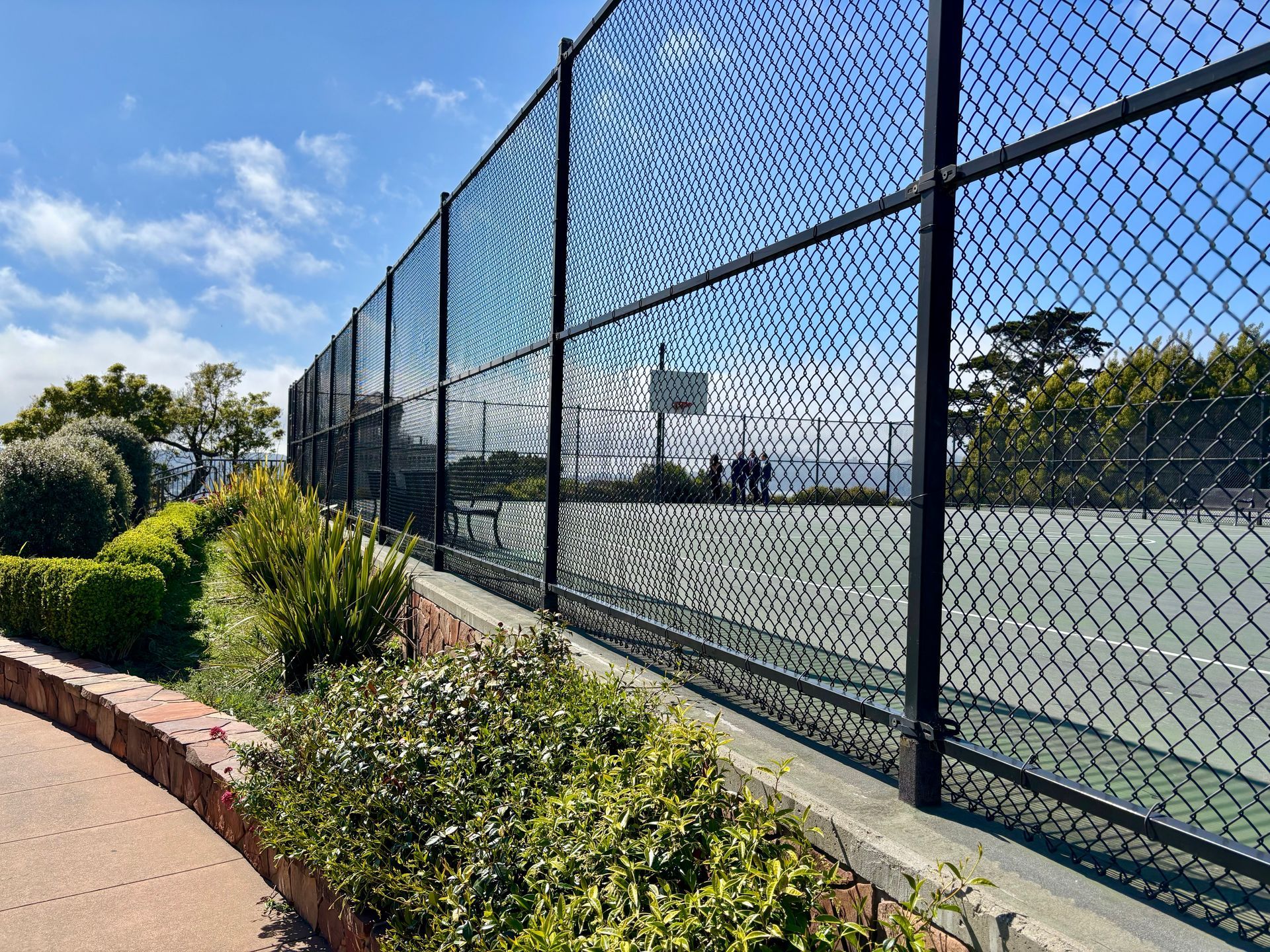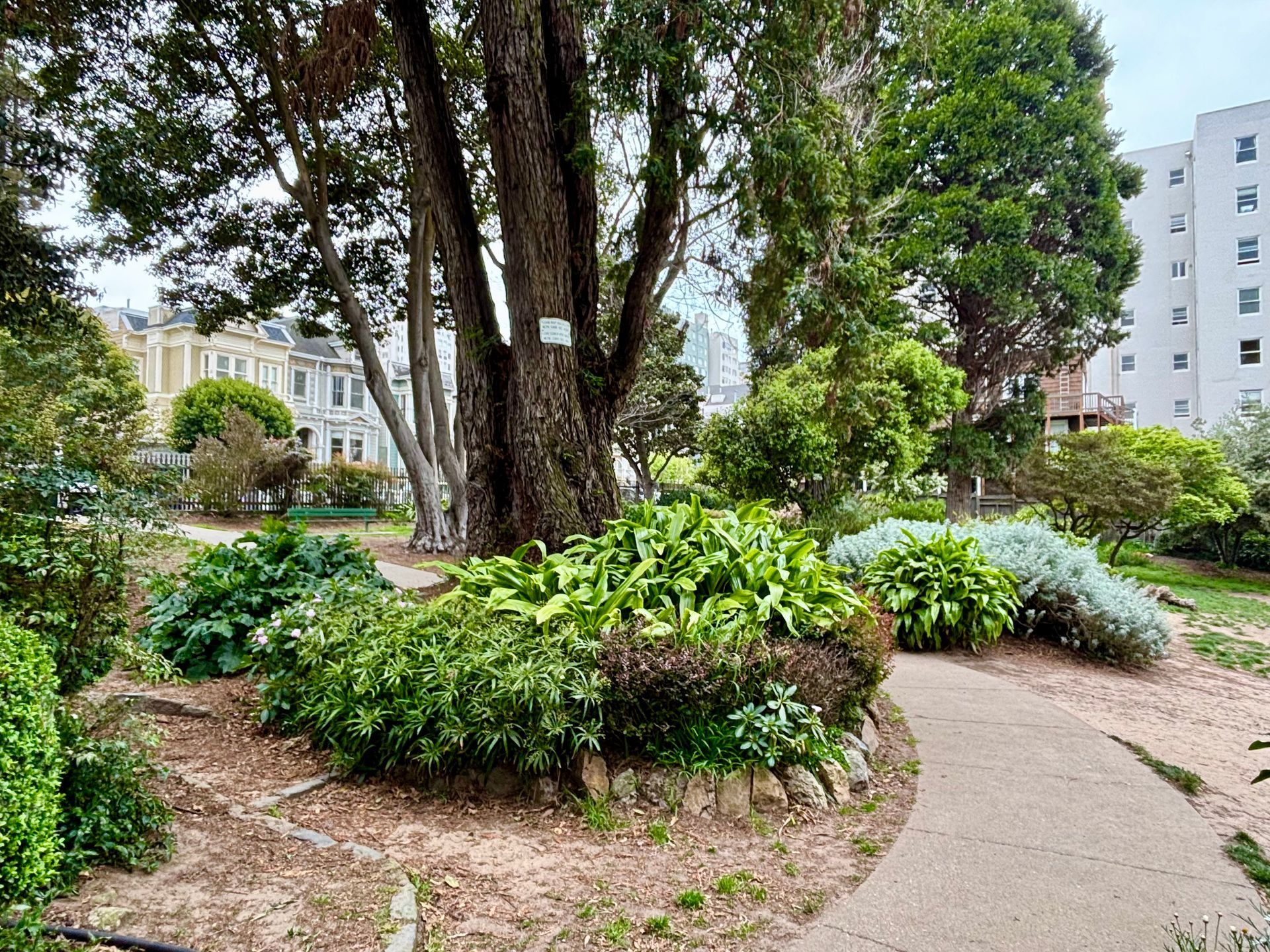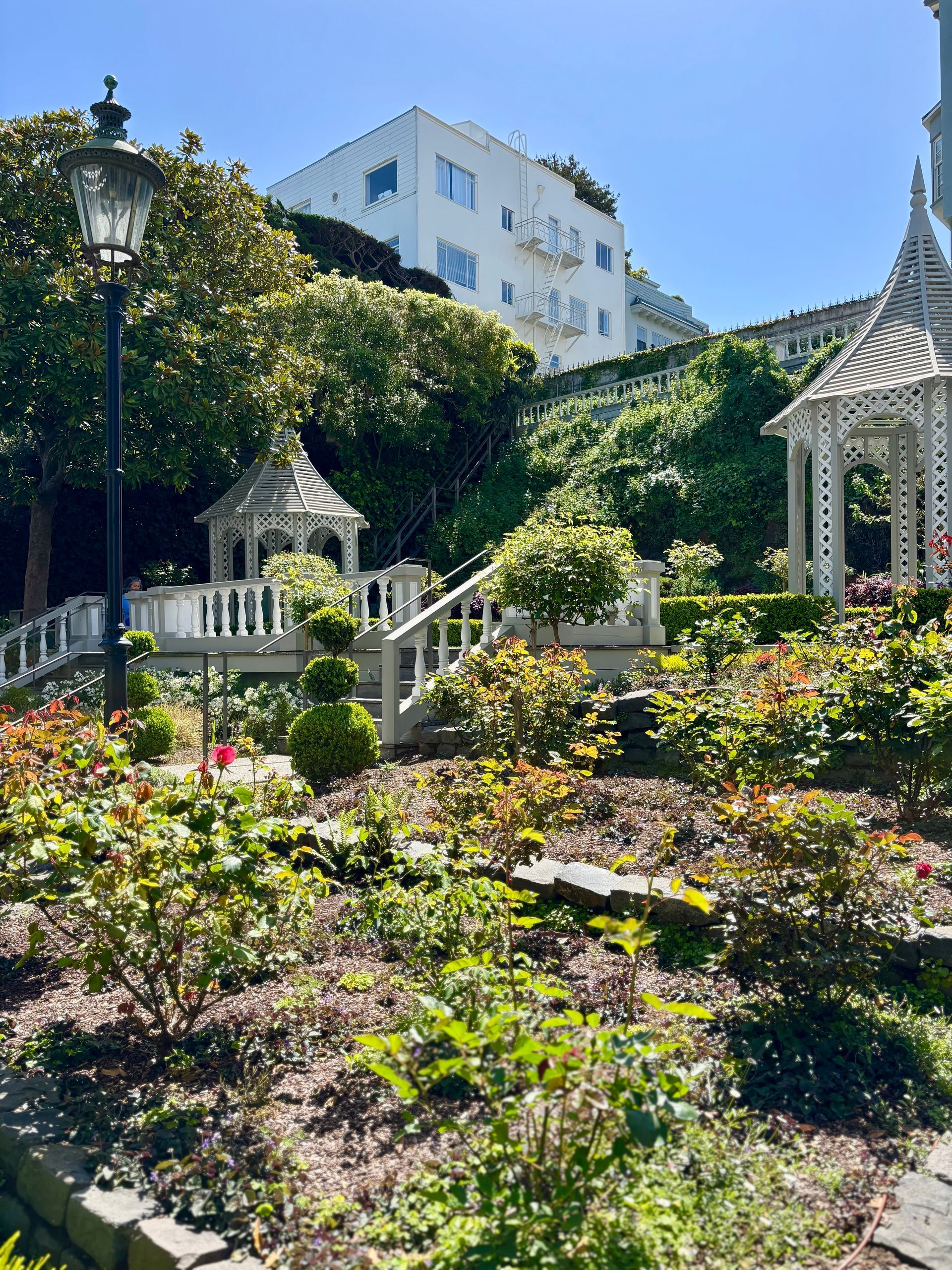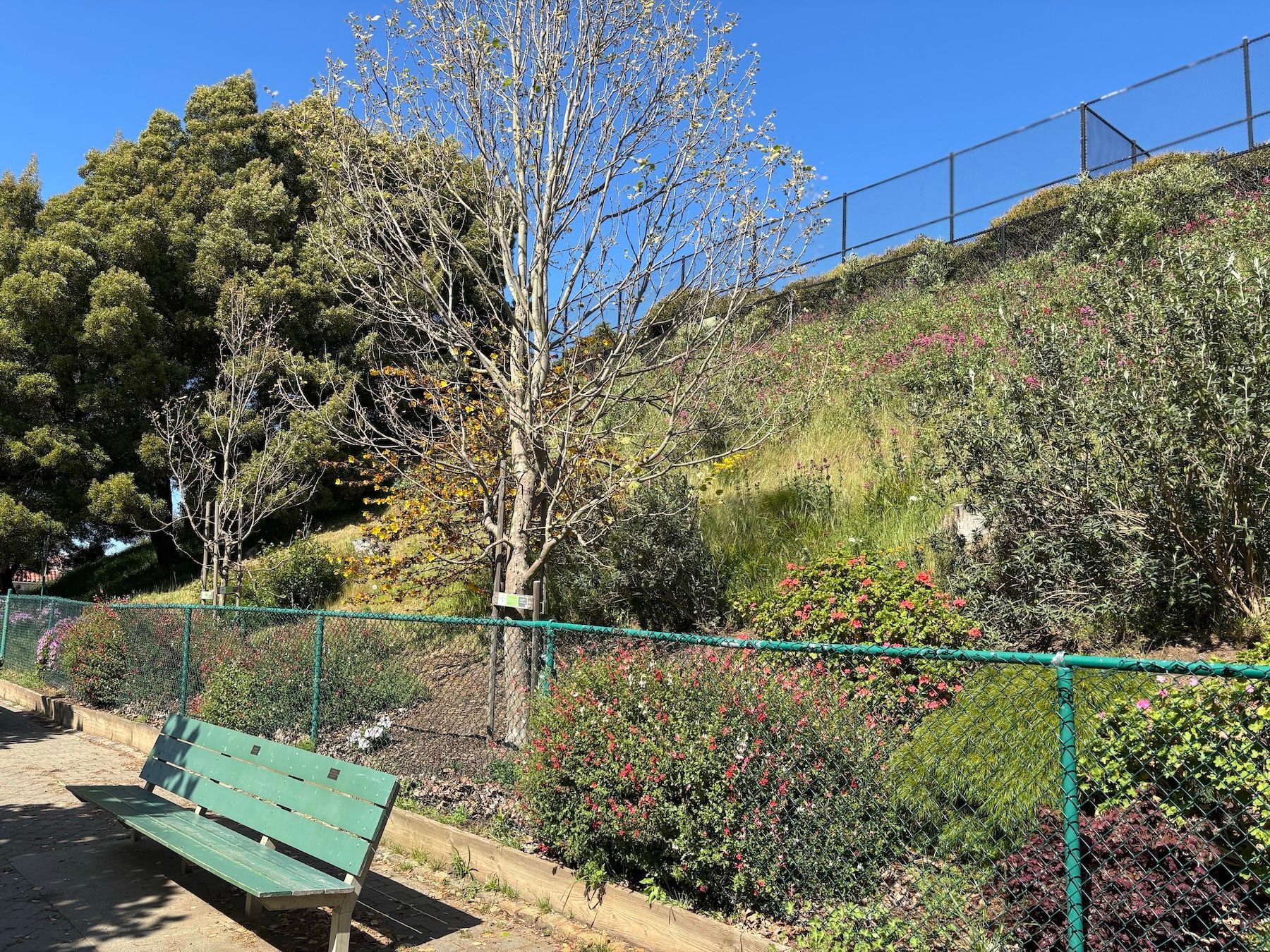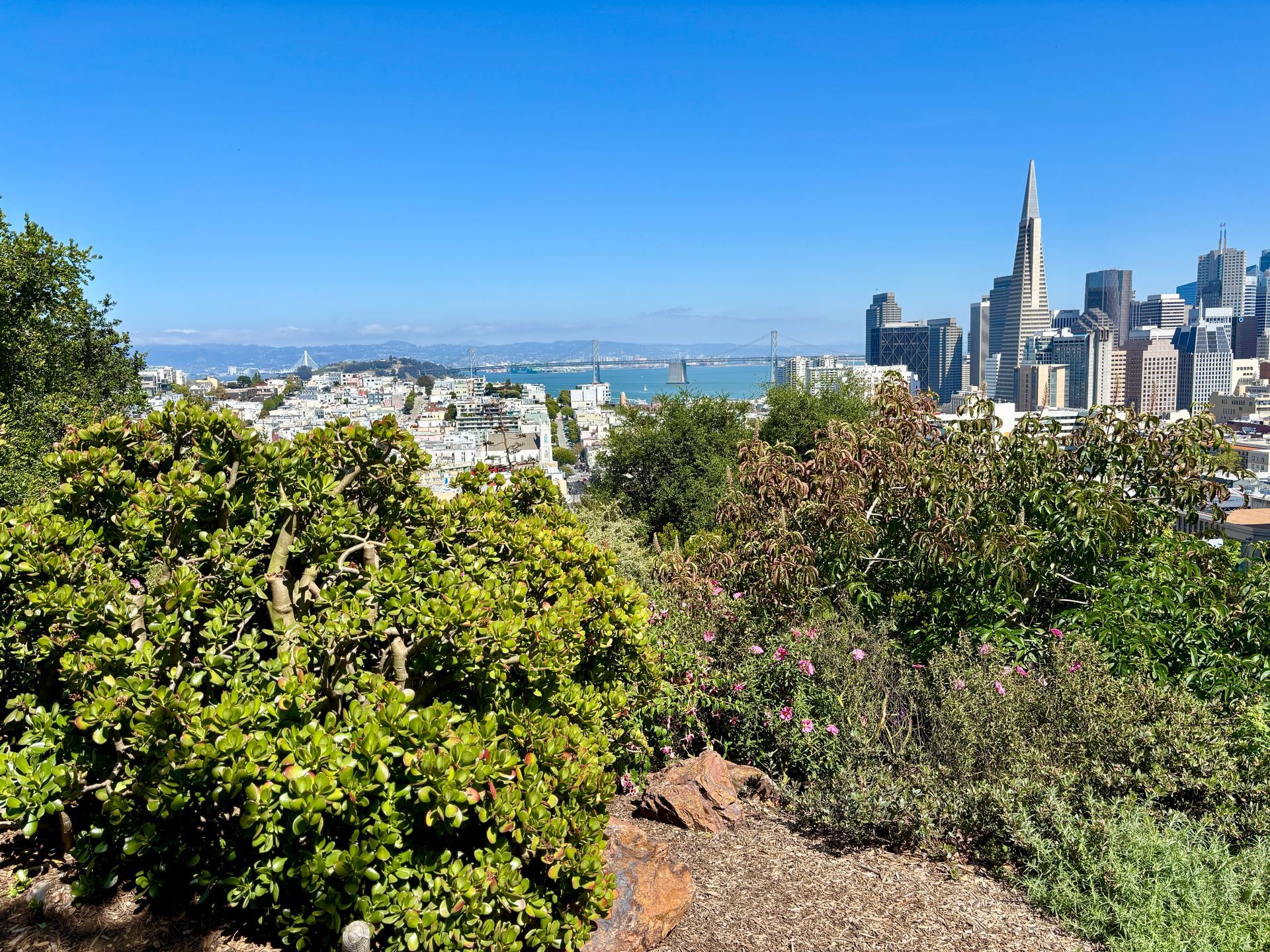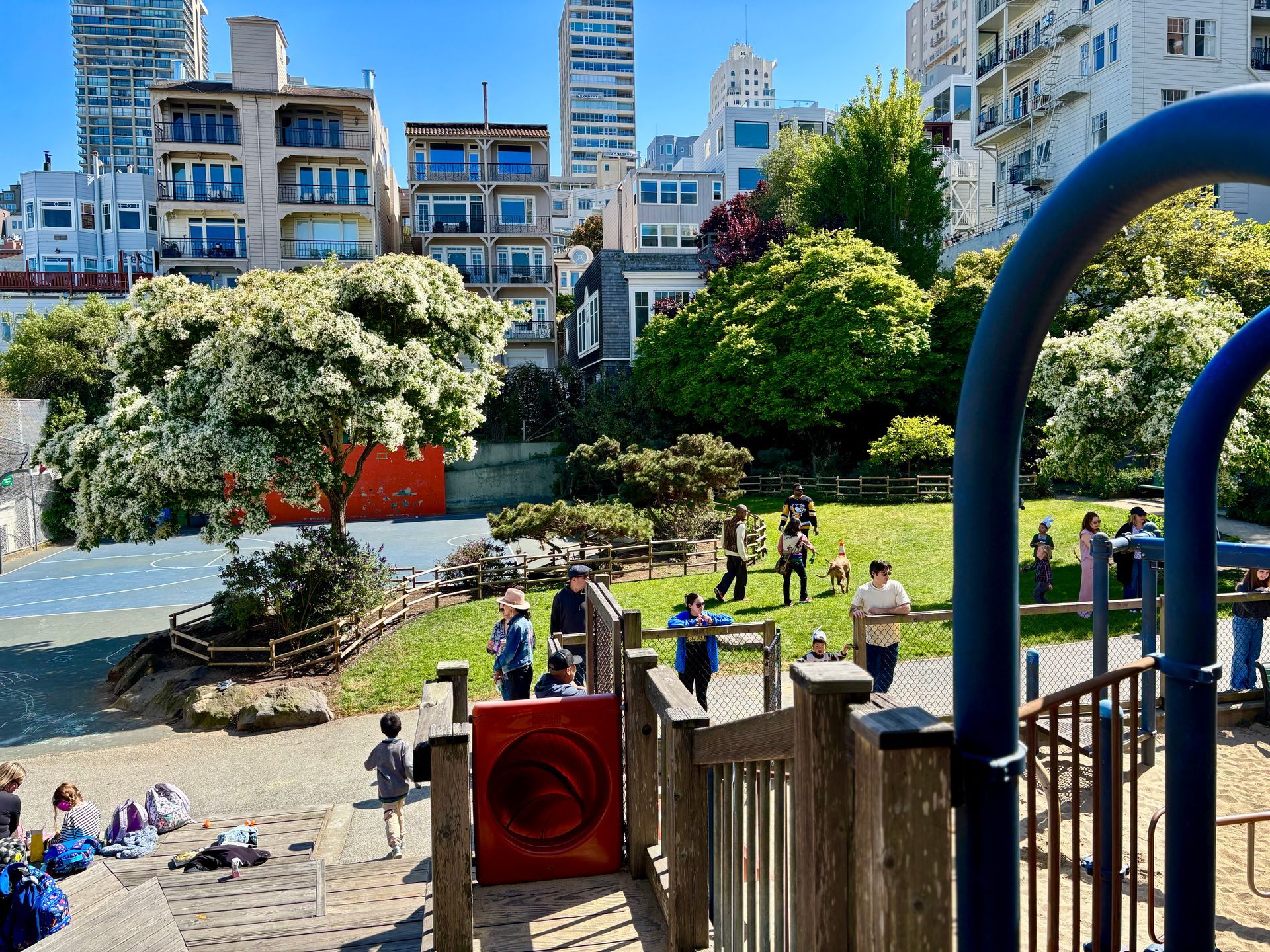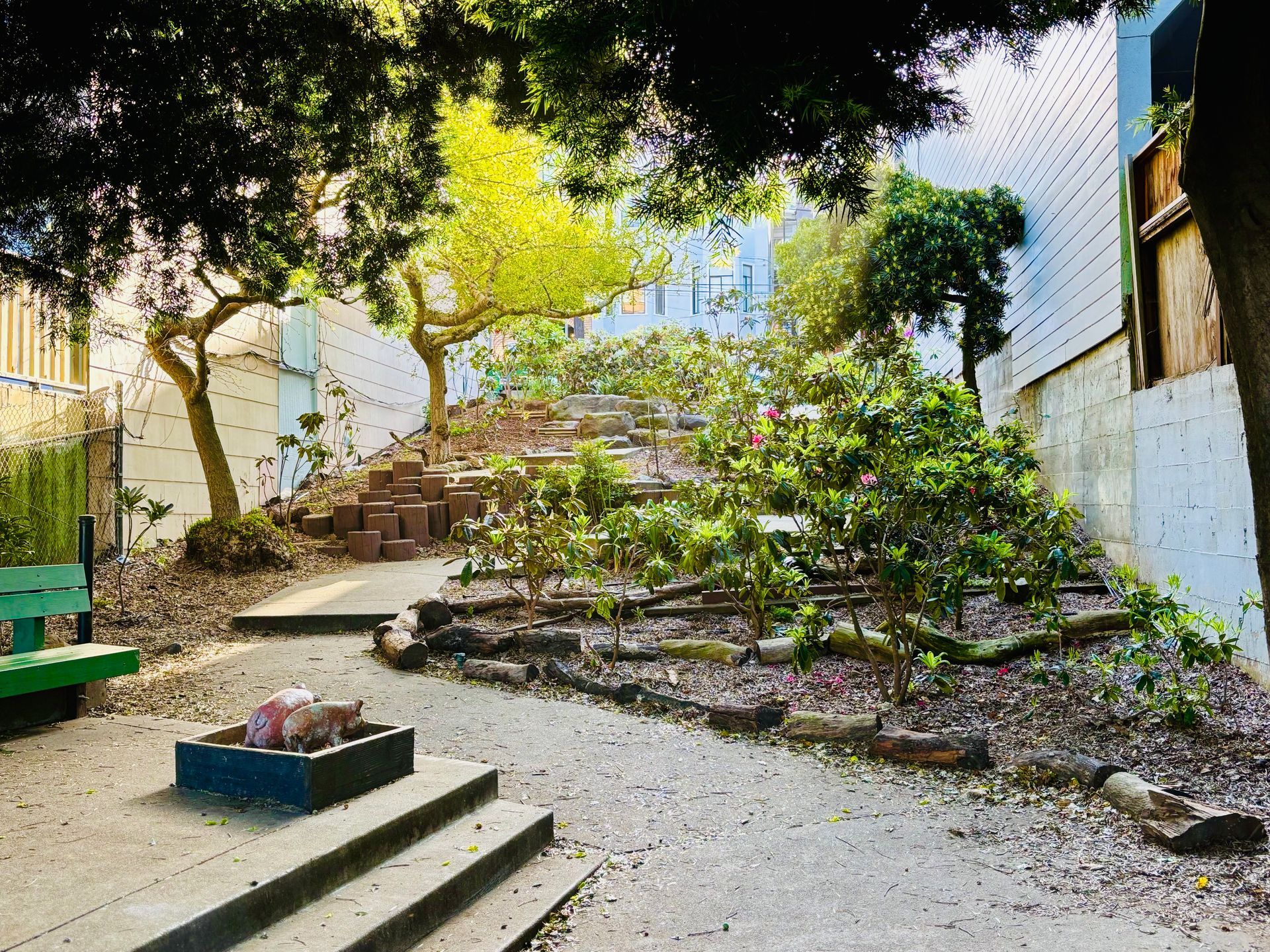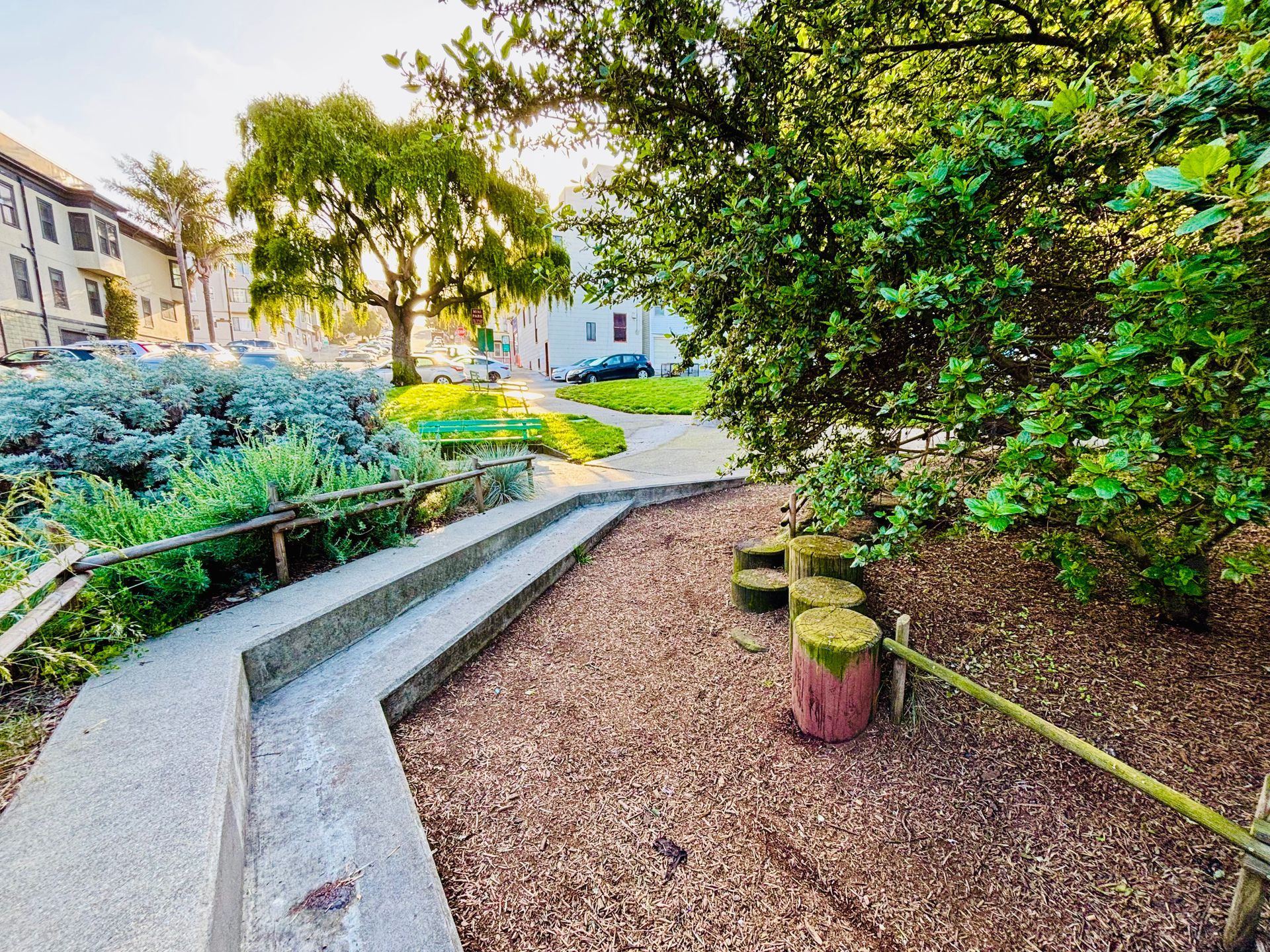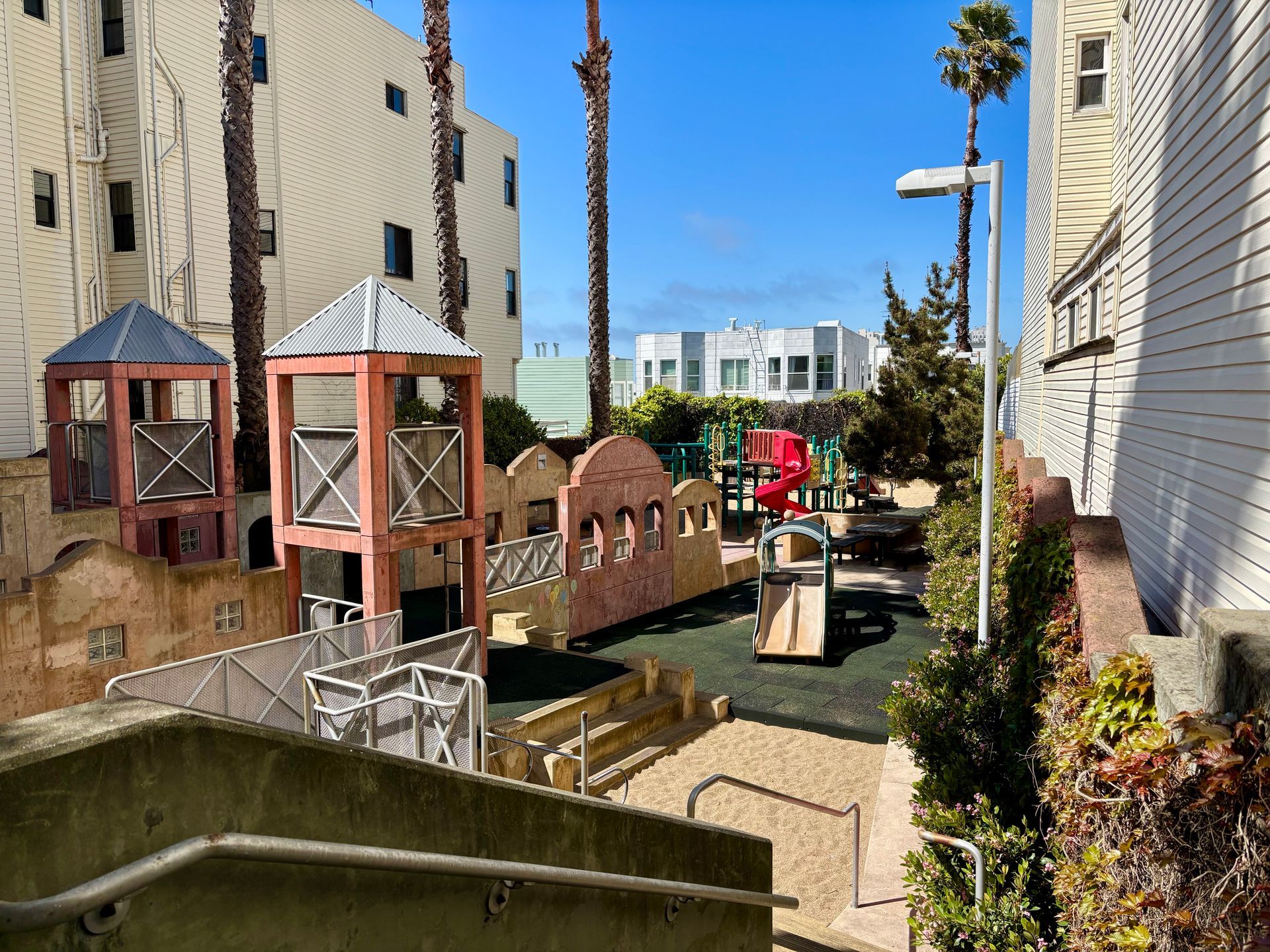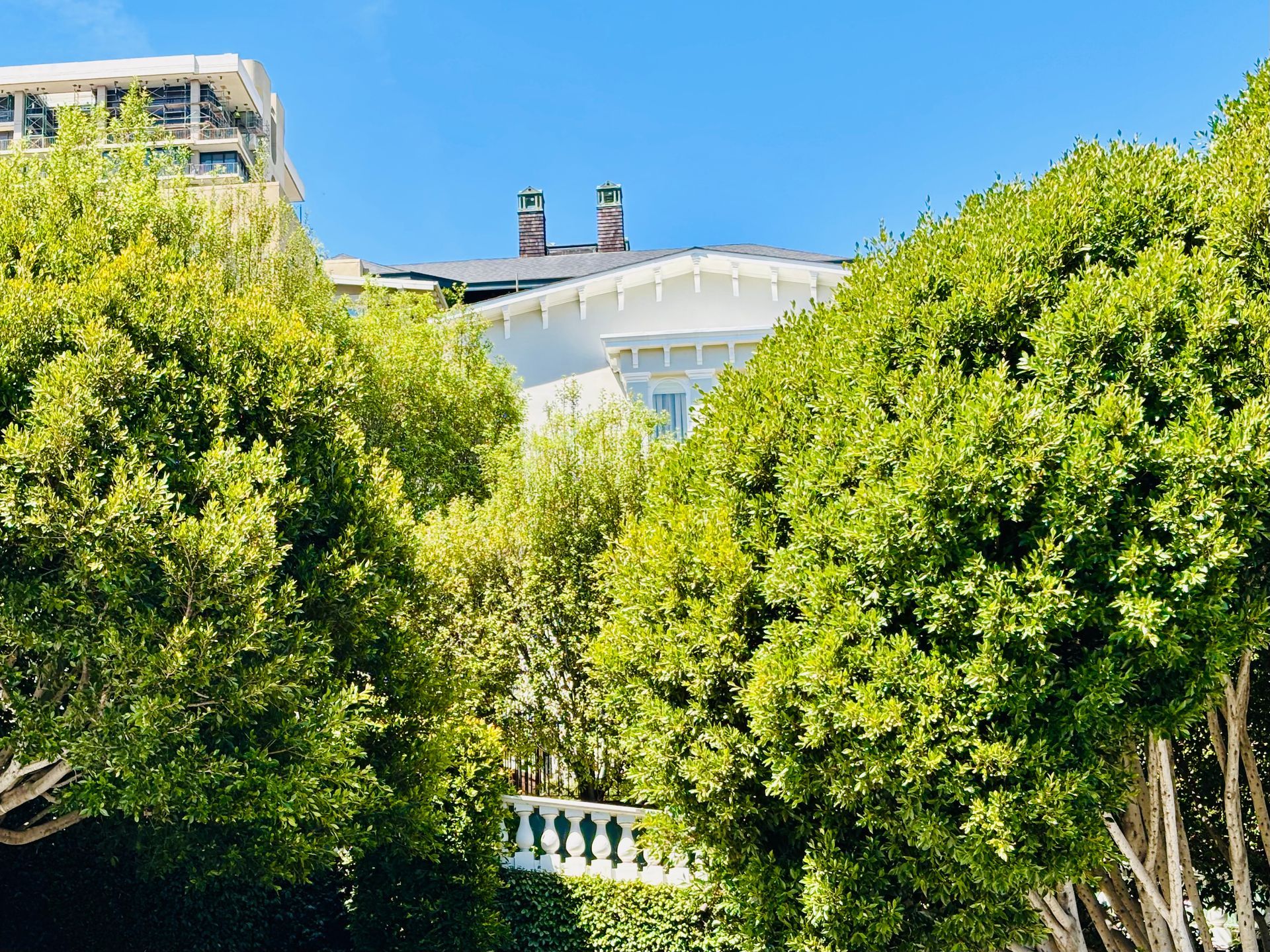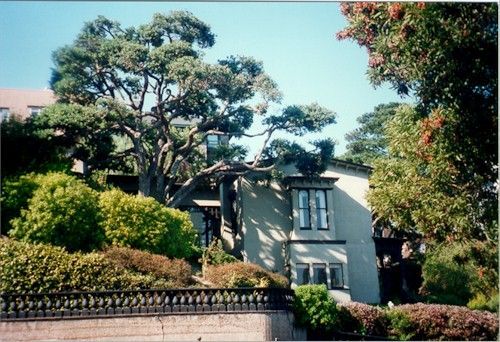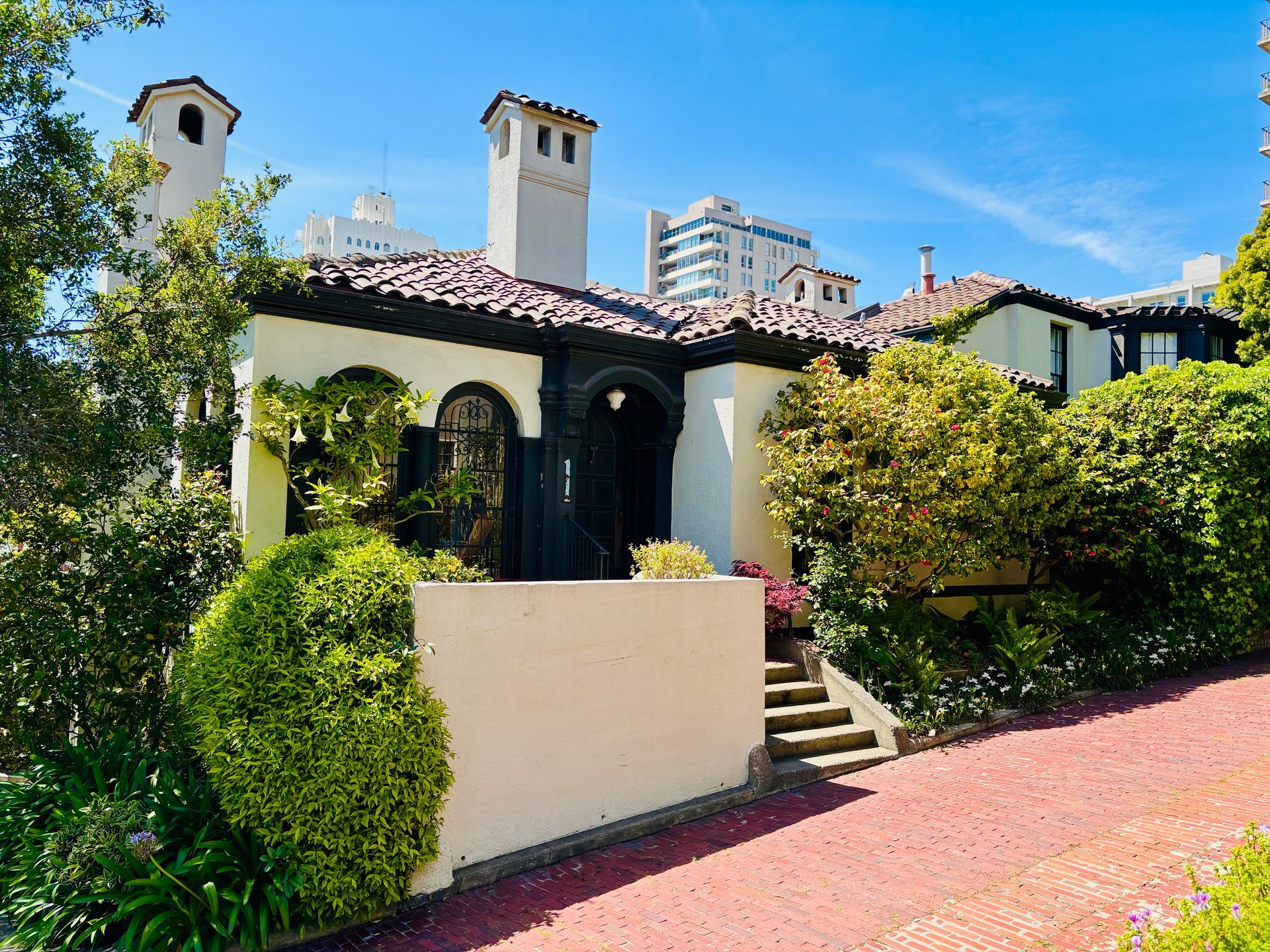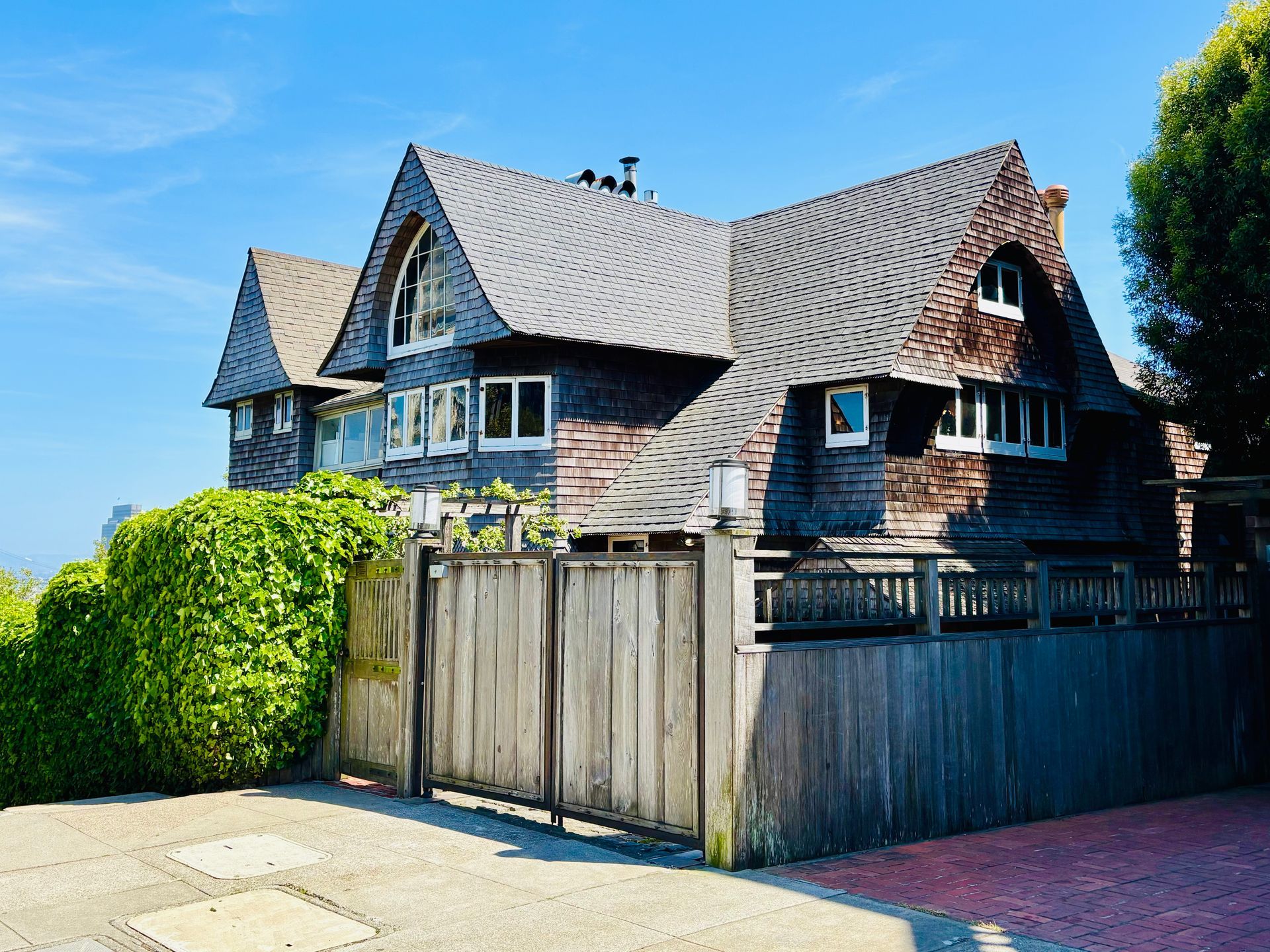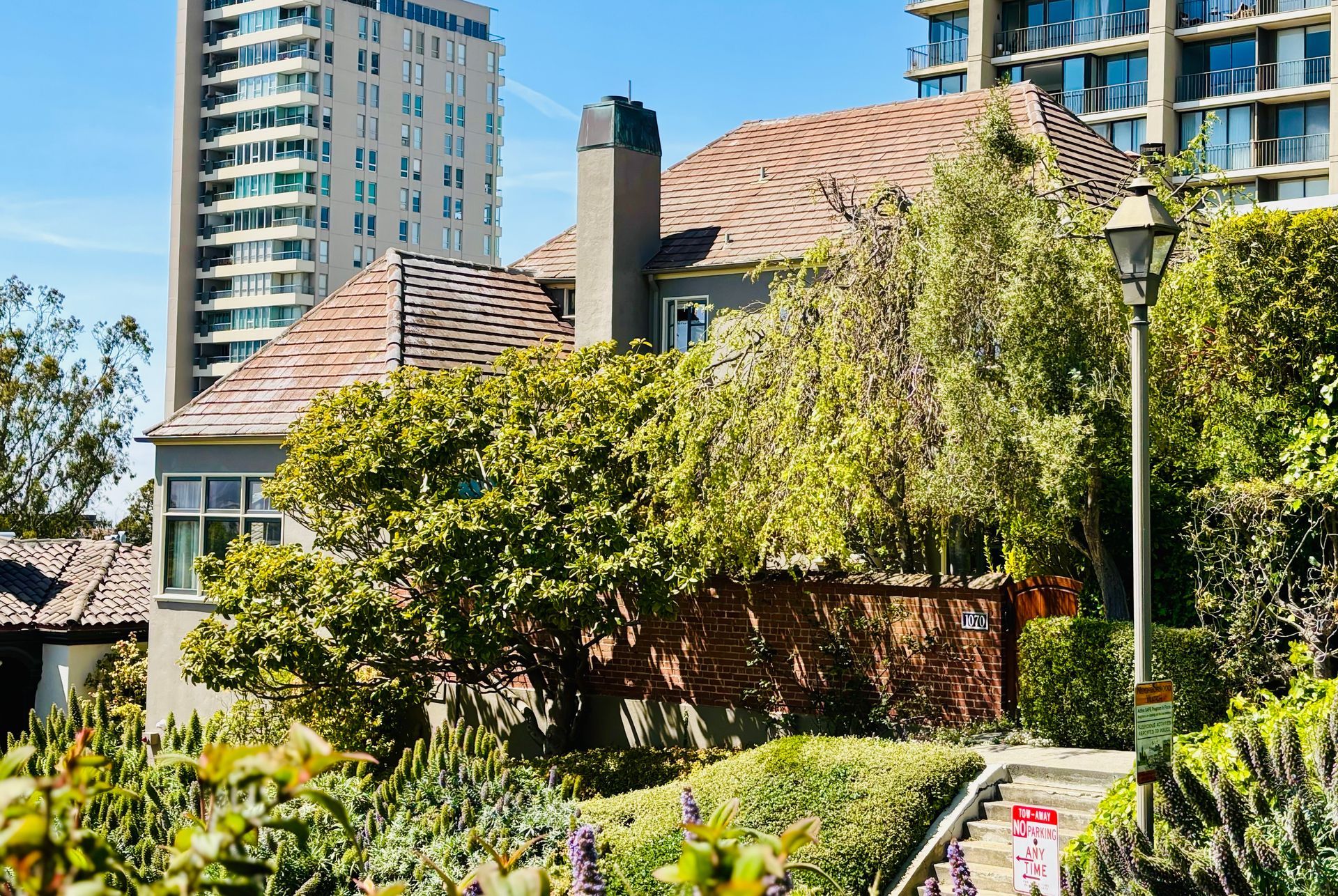WANDER. DISCOVER. REMEMBER.
EXPLORE RUSSIAN HILL.
HILLS, LANES, COTTAGES, AND VIEWS
STAIRWAY GARDENS OF RUSSIAN HILL
Russian Hill is best explored on foot—it's the only way to truly feel its charm. With hidden stairways, narrow alleys, and sweeping views around every corner, this compact, hilly neighborhood invites you to slow down and take it all in. You’ll find tucked-away cottages, lush gardens, unique architecture, and a rich layer of history woven throughout.
As you wander, pause to take in how the view shifts from one side of the street to the other; sometimes the best way to admire a hillside home is from across the street, or even a few blocks away.
Many of the stairways and walking lanes you’ll discover are lovingly maintained by local neighborhood associations, including ours. These dedicated groups raise funds, tend the gardens, and handle upkeep so we can all enjoy these peaceful paths.
Cars and tour buses aren’t allowed on these pedestrian-only lanes—just neighbors and visitors on foot. Each has its own personality, but all share a common trait: they’re cared for by nearby residents and meant for everyone to enjoy. As you explore, please respect the privacy of the people who call these lanes home.
And keep an ear out—you just might hear the famous
Wild Parrots of Telegraph Hill! These feathered visitors often make their way over to Russian Hill, especially around our three eastern slope stairways. If you hear chirping overhead, don’t worry—you’re not imagining it. Our neighborhood has become one of their favorite hangouts, too.
Chestnut Street Stairway Garden
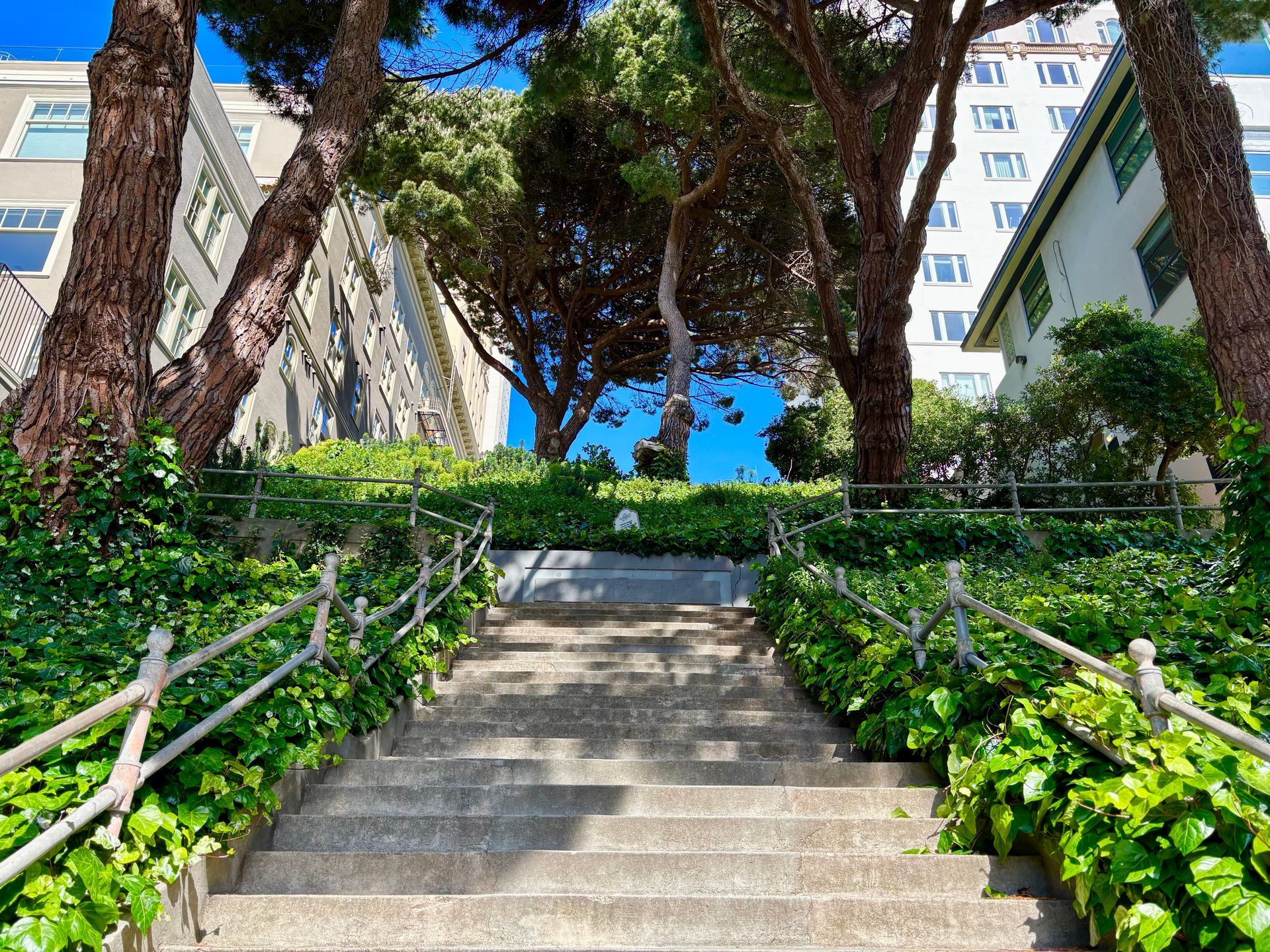
This shaded stairway begins on a quiet cul-de-sac at Chestnut and Larkin and winds down through a grove of magnificent Monterey and Canary Island pines. At the base, you’ll land on Chestnut Street, which continues on to Polk.
For a charming detour, head left (south) onto Culebra Terrace. You’ll pass a collection of small, character-filled cottages before reaching another set of steps that climb up to Lombard Street.
Green Street Stairway Garden
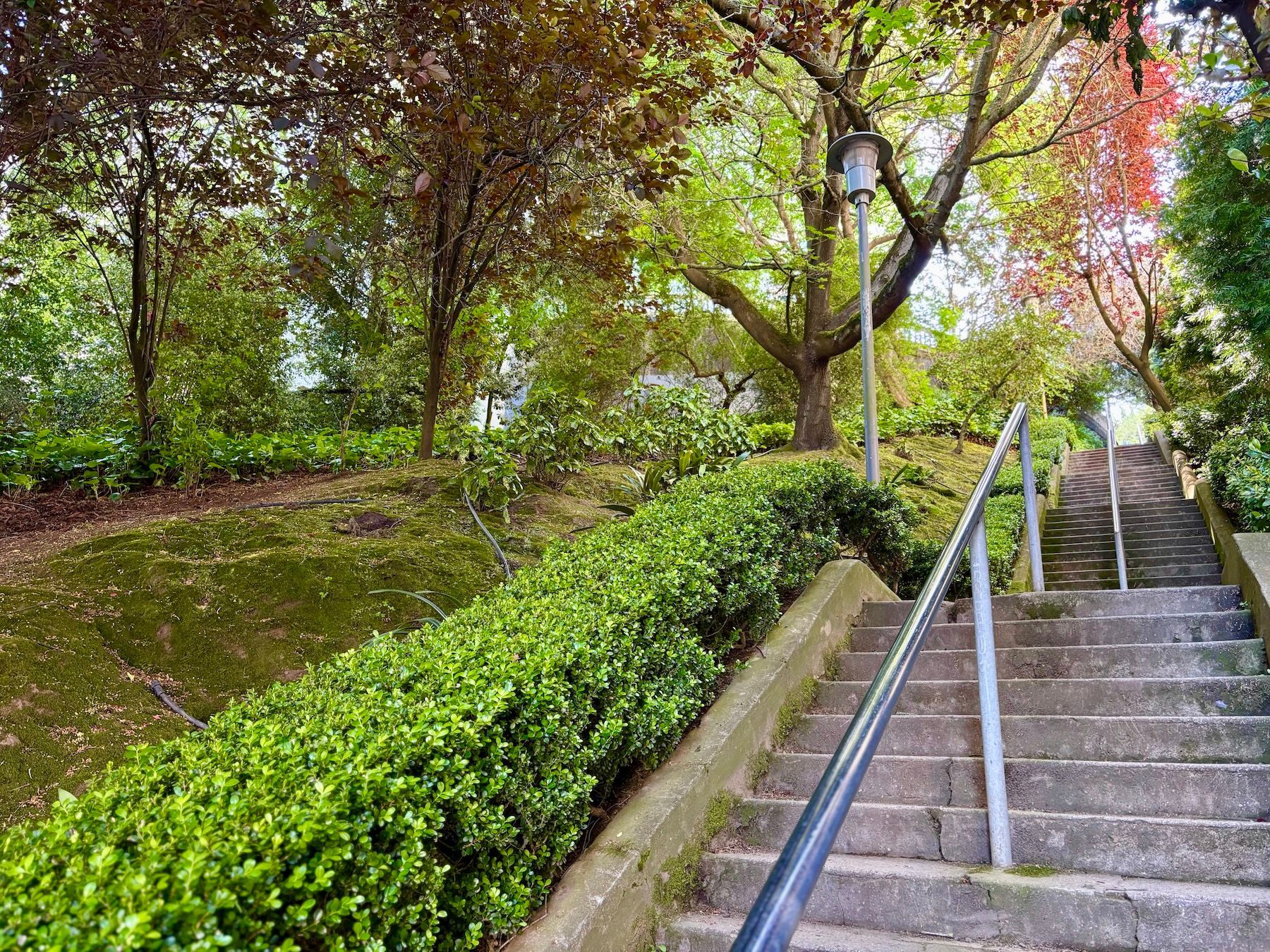
From the corner of Green and Jones, head east toward the start of the steps. As you walk from Jones to the steps, take note of the houses on the left (north) and the condominiums on the right (south).
Greenwich Garden Path
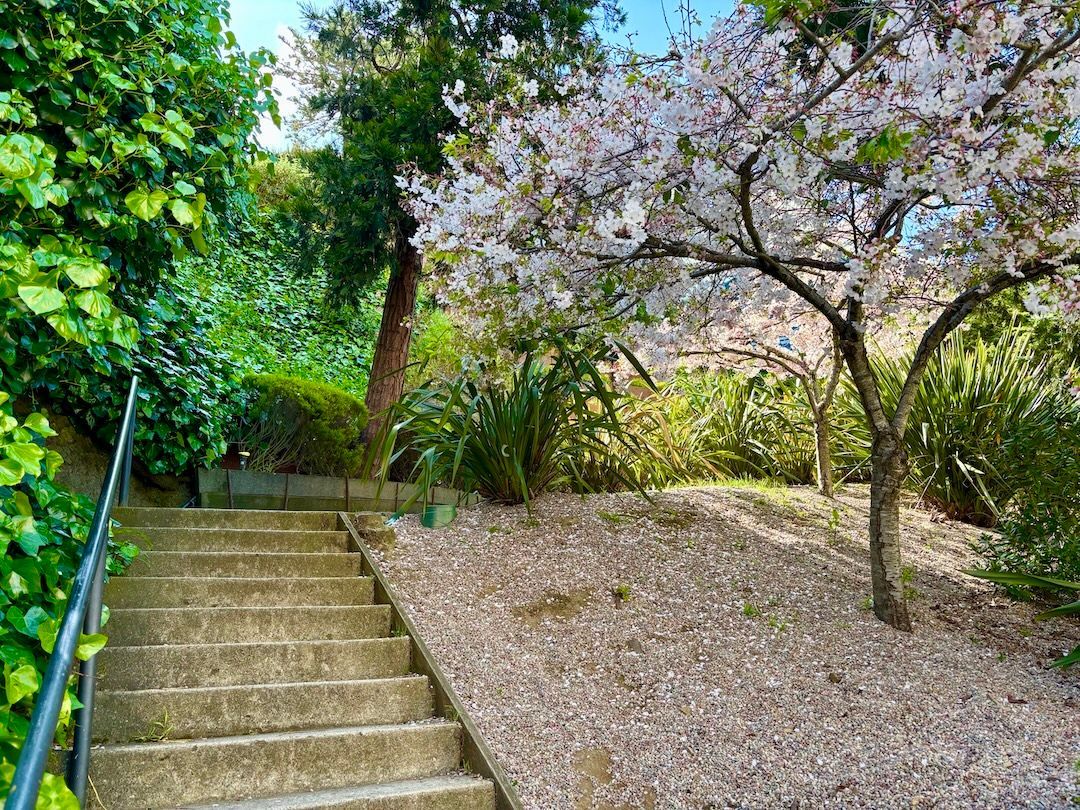
From the corner of Hyde and Greenwich, take note of the rose garden, created by a resident of the nearby building. Walk east to the bottom of the cul-de-sac, where the stairs begin.
Havens Place

This dead-end lane begins on the west side of Leavenworth, just north of the corner of Union and Leavenworth. Walk up a steep set of stairs to discover this urban gem. When the walk splits, take the left lane (the right one is privately owned). The gardens along this quiet, yet public, street are lovingly cultivated by the neighbors. Less well-known than Macondray Lane, it remains a hidden treasure.
Macondray Lane
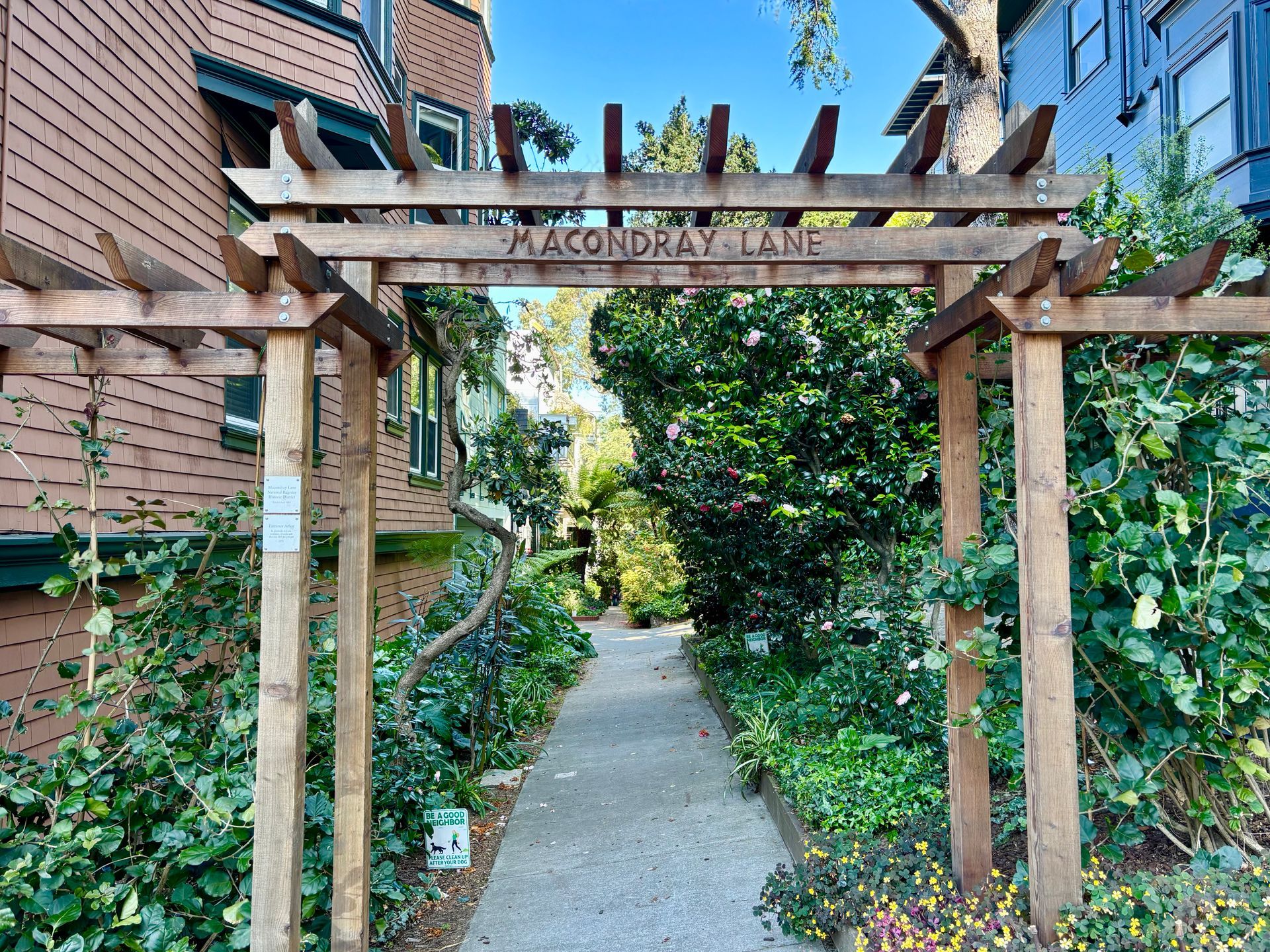
To find the start of this lane, head to Green and Leavenworth. On the east side of Leavenworth, walk north toward the bay. Turn right into what looks like a parking lot. The lane begins mid-block, crosses Jones, and then leads down a wooden stairway to Taylor Street.
Marion Place
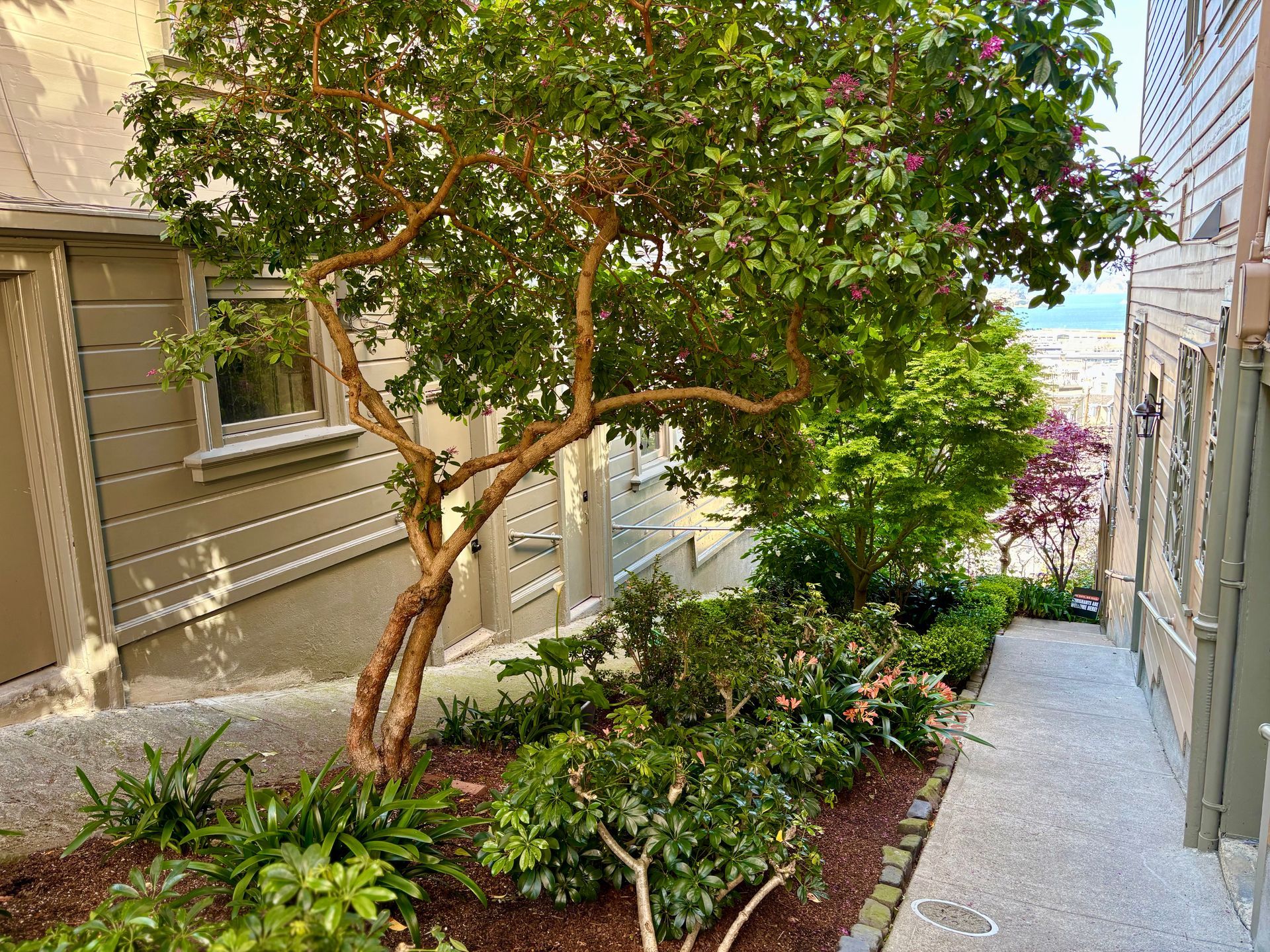
This steep, wooded walkway descends from the 900 block of Union Street, between Jones and Taylor. It leads to an apartment building, a garden on the east side, and a house at the end of Marion Place.
Sterling Park Stairway

Sometimes called the Greenwich Stairway, these steps begin at the wall on Greenwich, where the hill starts to slope down toward Larkin Street. What was once a weedy patch has been lovingly transformed by neighbors into a beautifully blooming flower garden.
Vallejo Stairway Garden
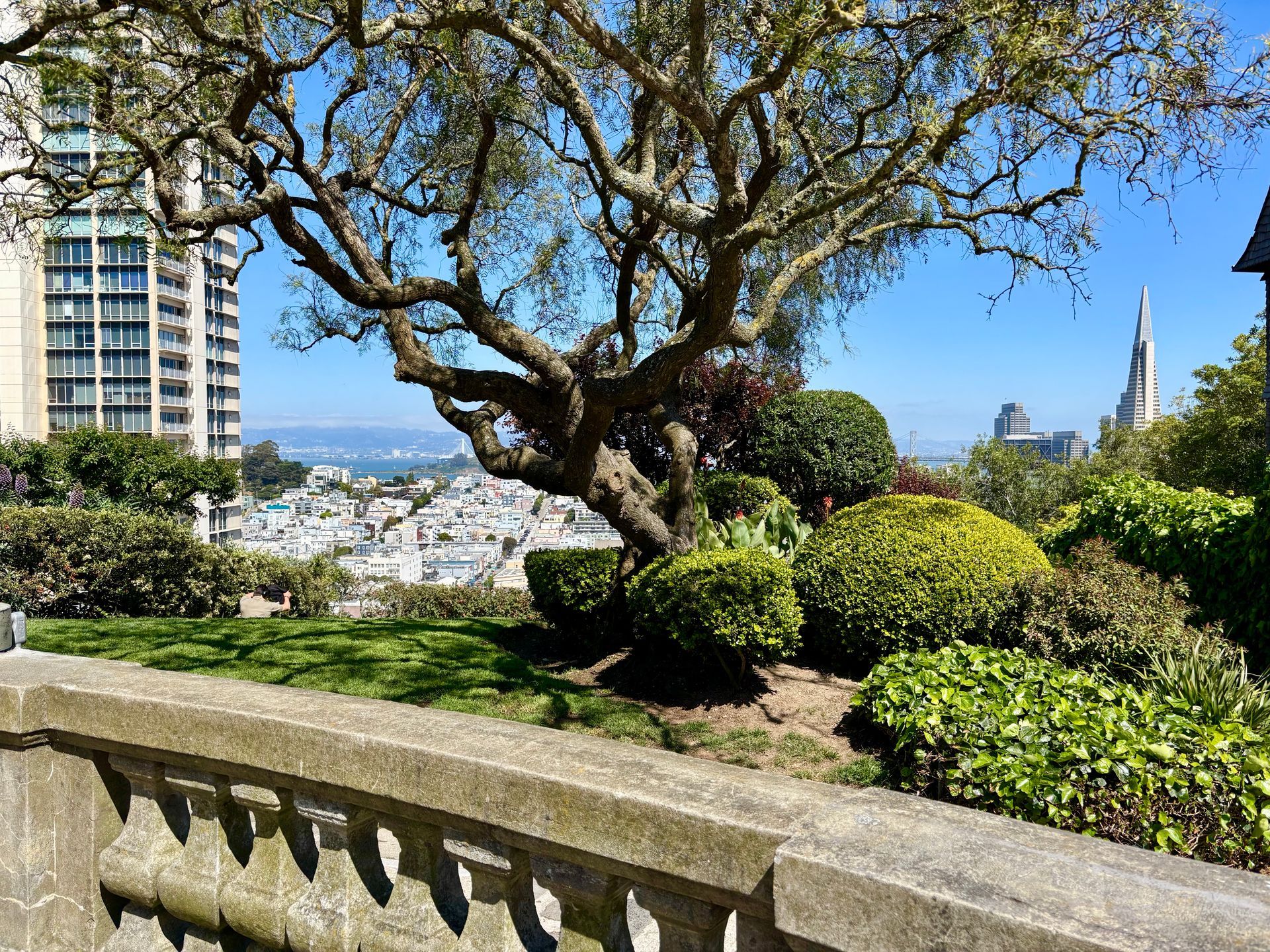
These steps begin at the balustrade on the east end of the paved 1000 block of Vallejo Street and zig-zag down to Taylor Street, passing by historic buildings along the way (see Summit Walk).
SANCTUARIES TUCKED BETWEEN THE STREETS
PARKS IN AND AROUND RUSSIAN HILL
A WALK THROUGH HISTORY, ONE STEP AT A TIME
RUSSIAN HILL WALKING TOURS
Taking a walk through Russian Hill lets you uncover the stories that make this neighborhood special. Each step brings you closer to its unique history and natural charm.
Russian Hill is a hilly, compact area with many stairways and small alleys that beg to be explored. It is a neighborhood that is best seen and felt by walking. You will find panoramic views, tucked-away cottages, gardens, interesting architecture, and lots of history.
As you wander around the hill, notice the different views from one side of the street to the other. Houses tucked away on the hillsides can often be best viewed from across the street or even blocks away.
Vallejo Crest Summit Walk
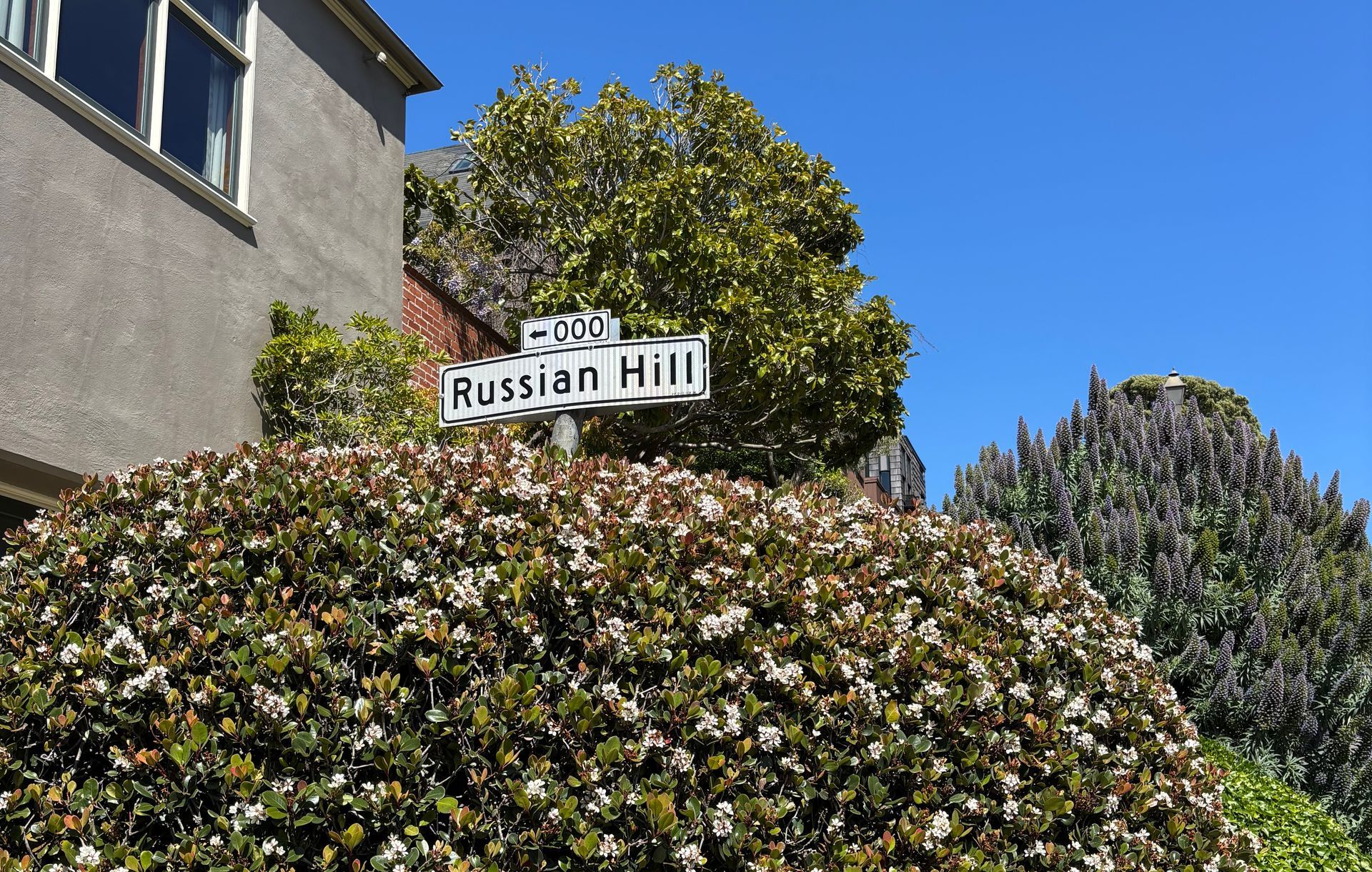 Download the Map and Route Guide
Download the Map and Route GuideRussian Hill’s Summit includes the highest point in Russian Hill, at 343 feet. More significantly, it includes some of the most important architecture and history of Russian Hill. Because of its historic significance, the area covered by this walk, the Vallejo Street Crest Historic District, was added to the National Register of Historic Places in 1987.
This walk starts at the corner of Jones and Vallejo Streets. It includes the 1000 block of Vallejo Street, Russian Hill Place, the Vallejo Steps Garden descending to Taylor Street, Taylor to Broadway, Broadway to Florence, the Florence Street Steps, and Florence Street.
The Northeast Slope
Download the Route GuideRussian Hill is a unique combination of urban elegance and rusticity. Virtually every block terminates in a spectacular view. There are miniature-scaled cottages and architect-designed apartment houses, formally landscaped gardens, and areas of comparative wilderness.
For this walk, you'll start at the southeast corner of Lombard and Hyde Streets.
The Northwest Slope
Download the Route GuideRussian Hill is a unique combination of urban elegance and rusticity. Virtually every block terminates in a spectacular view. There are miniature-scaled cottages and architect-designed apartment houses, formally landscaped gardens, and areas of comparative wilderness.
For this walk, you'll start at the southeast corner of Lombard and Larkin Streets.
Green Street and Macondray Lane
Download the Route GuideBegin your walk at the intersection of Vallejo and Jones Streets.
Walk north on Jones Street.
Additional City Walks Resources
The guides listed below highlight walks in Russian Hill, each offering its own unique charm. More importantly, they provide interesting routes across San Francisco, perfect for those who love exploring the city's diverse neighborhoods and districts.
Walking San Francisco on the Barbary Coast Trail, Daniel Bacon, 2021. Another fantastic San Francisco walking tour, this guide weaves fascinating anecdotes about the city’s early days. While it only touches on Russian Hill, it explores the surrounding area in a unique and captivating way. The tour is marked by bronze plaques, similar to those on Boston’s Freedom Trail.
Historic Walks in San Francisco, Rand Richards, 2001. This book offers 18 walks through the city’s history, with the Russian Hill walk starting on page 347. It also includes short biographies of notable figures from the city's past.
Lunchtime Walks in Downtown San Francisco, Gail Todd, 1998. This book features walks that start in downtown San Francisco, covering areas not typically found in other guides. Among the highlights are two 'aerobic' walks: one in Russian Hill—'Aerobic Walk to Russian Hill South – Walk 24'; and another on Telegraph Hill—'An Aerobic Tramp on San Francisco’s Long Trail: The Filbert & Greenwich Steps – Walk 22.'
San Francisco: The Ultimate Guide, Randolph Delehanty, 1995. The book includes 16 self-guided tours of the city. Tour Six takes you through Russian Hill, highlighting the history and architecture of its buildings.
Stairway Walks in San Francisco, Adah Bakalinsky, 1995. One of San Francisco’s hidden gems is its collection of over 350 stairways, winding through the city’s hills and offering breathtaking views, alternative routes, and a fun way to stay active. This book includes two walks through Russian Hill, with a special focus on the hidden spots that make this neighborhood so unique.
CRAFTED CORNERS AND TIMELESS FAÇADES
RUSSIAN HILL ARCHITECTURE
Italianate Architecture
Atkinson House: The oldest house in Russian Hill
1032 Broadway, between Jones and Taylor
Architect: William H. Ranlett, 1853
Russian Hill is rich in architectural tradition, both in the variety of styles and the number of renowned architects who left their individual stamps on the neighborhood. Many of these architects designed grand buildings in other parts of the city and country. Their buildings in Russian Hill reflect a constraint that allows them to fit into this neighborhood.
Russian Hill’s earliest residents were builders and architects. From 1853 to 1863, a partnership of Charles Homer (general contractor), William H. Ranlett (architect), and Joseph H. Atkinson (brick contractor) built the first period.
The next periods of Russian Hill design were from 1888 to 1906 and from 1908 to 1930. Willis Polk was active in Russian Hill in both periods.
Reverend Joseph Worcester (1888) and Willis Polk (houses and structures from 1891-1916) built the earliest arts and crafts shingle-style houses in San Francisco. The Newsom Brothers, known for their eccentric Victorians such as the Carson House in Eureka, built a more restrained Italianate house here (1885).
In the post-earthquake period (1912-1915), Charles Whittelsey and Charles McCall were responsible for much of the post-earthquake Pueblo and Spanish Colonial Mission Revival houses. John Galen Howard, who designed the plan for the University of California, Berkeley College of Environmental Design, is represented on Francisco Street (1912).
Julia Morgan, whose most famous work is San Simeon, designed two buildings: a Beaux Arts complete renovation (1916) and a First Bay Area Tradition shingle house (1917). Louis B. Hobart, who designed such varied buildings as Grace Cathedral, the California Academy of Sciences (1913-1931), and the Post-Modern Bank of America Clocktower (1939-1940), was the architect for 1050 Green (1913), an elegant, Parisian-style apartment building. Between 1912 and 1926, T. Patterson Ross built five elegant cooperatives. From 1909 to 1941, Albert Farr built two First and two Second Bay Area Tradition houses.
Bakewell and Brown, who designed San Francisco City Hall (1913-1915), designed the San Francisco Art Institute (1926). Bakewell built his own home across the street from the Institute. Timothy Pflueger designed the Alhambra Theater in 1930.
Renowned contemporary architects Gardner Dailey, William Wurster, Joseph Esherick, George Homsey, and Robert A. M. Stern have left their mark on the neighborhood. Landscape architect Thomas Church created at least five private gardens on the northern slope of Russian Hill.
RESEARCH RESOURCES
Bibliography of Russian Hill, San Francisco, and California History compiled by Elizabeth Wright
- Atherton, Gertrude, 1946. My San Francisco: A Wayward Biography. The Bobbs-Merrill Company, NY.
- Anthony, Gene and Jill Losson, 1981. The Great Cable Car Adventure Book. Presidio Press, Novato, CA.
- Bakalinsky, Ada, 1995. Stairway Walks in San Francisco. Lexikos, San Francisco.
- Beebe, Lucius and Charles Clegg, 1960. San Francisco’s Golden Era. Howell North, Berkeley, CA. [Great photos and pre-1906 Earthquake history.]
- Blaisdell, Marilyn & Robert Ehler Blaisdell, 1985. San Francisciana: Photographs of the Cliff House. Marilyn Blaisdell (Publisher).
- Blotnik, Elihu, 1983. Russian Hill. California Street Editions, San Francisco [Poetry].
- Brady, Matthew, 1992. The Old Town: Real Life in Early San Francisco. Independent Books, San Francisco.[Brady write a ‘SF history column in The Independent each week.]
- Bronson, William, 1959. The Earth Shook and the Sky Burned. Doubleday & Company, Inc., Garden City, NY.
- Broussard, Albaert S., 1993. Black San Francisco: The Struggle for Racial Equality in the West, 1900-1954. University Press of Kansas, Lawrence, Kansas
- Caen, Herb, 1976. One Man’s San Francisco. Comstock Editions, Inc., Sausalito, NY
- Carroll, Jon, 1993. Near Life Experiences: The Best of Jon Carroll. Chronicle Books, San Francisco.[Carroll is a columnist for the SF Chronicle.]
- Chandler, Arthur, 1977. Old Tales of San Francisco. Kendall/Hunt Publishing Co., Dubuque, IA. [Good for pre-1906 history.]
- Chinn, Thomas W., 1989. Bridging the Pacific: Chinatown and Its People. Chinese Historical Society, San Francisco.
- Chronicle News Staff, 1989. The Quake of ’89. Chronicle Books, San Francisco.
- Delehanty, Randolph, 1995. San Francisco: The Ultimate Guide. Chronicle Books, San Franciscos.
- Delehanty, Randolph, Sexton, Richard, 1991. In The Victorian Style. Chronicle Book
- Dickson, Samuel, 1968. Tales of San Francisco. Standord University Press, Sanford, CA.[Good for pre-1906 SF history and also for post-1906 personalities.]
- Dillon, Richard, 1985. North Beach: The Italian Heart of San Francisco. Presidio Press, Novato, CA. [Great book about North Beach and some about Russian Hill personalities.]
- The Discovery of San Francisco Bay: The Portola Expedition of 1769-1770, 1992. Edited by Peter Browning. Great West Books, Lafayette, CA [Diary of Ensign Miguel Constanso, engineer with the Portola expedition, in both Spanish and English (on opposing pages).]
- Dolon, Bill and Karen Warner, 1985. San Francisco Trivia. 101 Productions, San Francisco.
- Drescher, Timothy W., 1991. San Francisco Murals: Community Creates Its Muse, 1914-1990. Pogo Press, Inc.
- Ferlinghetti, Lawrence and Nancy J. Peters, 1980. Literary San Francisco: A Pictorial History from Its Beginnings to the Present Day. City Lights Books and Harper & Row Publishers, San Francisco.
- Gentry, Curt, 1964. The Madams of San Francisco. New American Library, NY.
- Gentry, Curt, 1968. The Last Days of the Late Great State of California. Ballantine Books, NY.
- Hansen, Gladys, 1980. San Francisco Almanac. Presidio Press, San Rafael, CA
- Hansen, Gladys and Emmet Condon, 1989, Denial of Disaster, Cameron and Company, San Francisco, CA.
- Hockaday, Joan & Henry Bowles, 1988. The Gardens of San Francisco. Timber Press, Portland, Oregon.
- Hynding, Alan A., 1976. California Historymakers. Kendall/Hunt Publishing Co., Dubuque, IA. [Brief biographies of important historical personages from both northern and southern California.]
- Kahn, Edgar M., 1940. Cable Car Days in San Francisco. Stanford University Press, Stanford University, CA.
- Kostura, William, 1997. Russian Hill: The Summit 1853-1906: Volume I of a Neighborhood History. Aerie Publications, San Francisco, CA [Very good on history of property and how it developed at the top of Russian Hill, and great source of resources. There are supposed to be four volumes to follow regarding the rest of Russian Hill.]
- Margolin, Malcolm, 1978. The Ohlone Way: Indian Life in the San Francisco-Monterey Bay Area. Heydey Books, Berkeley, CA.
- Martin, Mildred Crowl, 1977. Chinatown’s Angry Angel: The Story of Donaldina Cameron. Pacific Books, Publishers, Palo Alto, CA. [Biography of Cameron and how she was instrumental in bringing an end to slavery in Chinatown.]
- McGrew, Patrick and Brenner, Marion, 1991. Landmarks of San Francisco. Henry Abrams, Inc., Publishers, New York.
- Moudon, Anne Vernez, 1989. Built for Change, Neighborhood Architecture in San Francisco. The MIT Press.
- Muscaline, Dorothy, 1975. Old San Francisco: The Biography of A City from Early Days to the Earthquake. GP Putnam’s Sons, NY.
- Narell, Irena, 1981. Our City: The Jews of San Francisco. Howell-North Books, San Diego, CA. [Excellent book about Jewish families who settled in SF and are still influential.]
- 1990 California Almanac, 4th ed. James S. Fay, Sr. Ed. Pacific Data Resources.
- Pickelhaupt, Bill, 1995. Club Rowing on San Francisco Bay, 1869-1939 Featuring The South End Rowing Club. Bill Pickelhaupt, San Francisco, CA. [South End Rowing Club is still in existence down at the waterfront in the neighborhood of the Maritime Museum.]
- Pickelhaupt, Bill, 1996. Shanghaied in San Francisco. Flyblister Press, San Francisco, CA.
- Richards, Rand, 1991. Historic San Francisco: A Concise History and Guide. Heritage House Publishers, San Francisco. Margolin, Malcolm, 1978. The Ohlone Way: Indian Life in the San Francisco – Monterey Bay Area. Heyday Books, Berkelely, CA
- Robinson, Judith, 1991. The Hearsts: An American Dynasty. Avon Books, NY [Since Hearsts owned major property on Russian Hill and lived on the hill, good source for Russian Hill history as well as for history of famous SF family … newspaper publishers.]
- Robinson, Judith, 1994. “You’re in Your Mother’s Arms”: The Life and Legacy of Congressman Phil Burton. Judith Robinson (Publisher), San Francisco, CA. [Autobiography of Phil Burton. Good modern history of SF.]
- San Francisco Chronicle, 1959. The Hills of San Francisco. The Chronicle Publishing Co., San Francisco.
- San Francisco Memoirs 1835-1851: Eyewitness accounts of the birth of a city, 1994. Compiled and introduced by Malcolm E. Barker. Londonborn Publications, San Francisco, CA. [Very good history of the beginnings of SF.]
- San Francisco Memoirs 1852-1899: The ripening years, 1996. Compiled and introduced by Malcolm E. Barker. Londonborn Publications, San Francsico, CA. [Very good history of continuing development of early SF.]
- San Francisco Stories, 1990. John Miller, ed. Chronicle Books., San Francisco.
- Savellli, Ben A., 1996. My Silent Partner. Published by Ben A Savelli, San Francisco, CA. [First person account of growing up in San Francisco, starting in the Depression years. Very folksy. Attended Galileo HS, parents owned grocery at Polk & Greenwich.]
- Schwartzenberg, Susan, 1996. Cento: A Market Street Journal. The San Francisco Art Commission, San Francisco, CA [Pictorial essay of Market Street.]
- Sexton, Richard, 1989, The Cottage Book, Chronicle Books, San Francisco.
- Shilts, Randy, 1987. And the Band Played On: Politics, People and the AIDS Epidemic. Quality Paperback Book Club, NY. [History of the AIDS Epidemic.]
- Silver, Mae, 1992. Rancho San Miguel. Stanyan Printing, San Francisco.
- Stanford, Sally, 1966. The Lady of the House: The Autobiography of Sally Stanford. Comstock Editions, Inc., Sausalito, CA. [The ‘Verdier Mansion’ at 1001 Vallejo is rumored to have been one of Sally Stanford’s ‘houses’ during World War II.]
- Sutherland, Monica, 1959. The Damndest Finest Ruins. Ballantine Books, Inc., NY.
- Tchen, John Kuo Wei, 1984. Genthe’s Photographs of San Francisco’s Old Chinatown. Dover Publications, Inc., NY. [Great Chinatown photos.]
- Thollander, Earl, 1987. San Francisco: 30 Walking Tours from The Embarcadero to the Golden Gate. Clarkson N. Potter, Inc. Publishers, NY.
- The Western Gate: A San Francisco Reader, 1952. Joseph Henry Jackson, ed. Farrar, Straus & Young, NY. [Great collection of excerpts from newspapers, novels, etc. all having to do with SF history.]
- Wollenberg, Charles, 1985. Golden Gate Metropolis: Perspectives on Bay Area History. Institute of Governmental Studies, University of California, Berkeley, Berkeley, CA.
- Wong, Jade Snow, 1945. Fifth Chinese Daughter. University of Washington Press, Seattle, WA. [Personal account of growing up Chinese in SF and in America. Author is accomplished artisan, creating beautiful enameled copper bowls, a travel agent, and owns a gift shop on Polk Street near Filbert.]
- Woodbridge, Sally B., John M. Woodbridge, & Chuck Byrne, 1992. San Francisco Architecture. Chronicle Books, San Francisco. [Good reference for types of architecture with photographs indicating where buildings are located.]

